Mindelo – San Vincente Island
After our 6 day sail from La Gomera (Canary Is), we arrived in Mindelo marina, on the island of San Vincente, Cape Verde Islands.

Mindelo harbour
Mindelo is a feast for the senses, from the colourful fruit market with many types of banana, papaya and root vegetables to the fish market with its rather overwhelming scents and sights and an incredible collection of fish. Apparently this is one of the under-fished areas of the world. Huge locally caught tuna were being carved up and sold in the market, in doorways, on planks in the park….


locals buying fish, Mindelo




Santo Antao Island
As the trade winds haven’t yet arrived, the forecast for a few days of light winds meant it was a perfect time for us to head for the adjacent island of Santo Antao, a one hour ferry ride away, which we had heard was great for walking.
It wasn’t easy to find out about the island, but we managed to book a small guesthouse, Casa Cavaquinho, in the small village of Cha de Manuel dos Santos a the top of Paul Valley.

Casa Cavaquinho – orange building
It was a great find, helpful hosts, delicious food, with stunning views down the valley from our comfortable room. Jose arranged the local shuttle (aguluera) from Porto Novo to bring us to the hotel. The other, more expensive option was to dropped at the top of the Cova de Paul and then walking down into the Paul valley. Jose’s suggested walk to Pico d’Antonio and down the Paul Valley. This took us via the villages of Chazinja, Cha de Mato, then up to the peak, then down to Boca de Figueiral. Jose gave us a laminated card with the route and directions, but said to ask the friendly locals, which we did many times, especially when we took a wrong turn at the pig….

The path winds through small villages, fields of sugar cane, banana and coffee.

Unlike the other islands, water is plentiful in this valley. Large catchment areas such as this one are used for bathing, washing and irrigation.
 As we cautiously trekked down the cobbled paths we pass the locals carrying their produce or building products.
As we cautiously trekked down the cobbled paths we pass the locals carrying their produce or building products.

0r offering their produce for sale.


A lunchtime stop in Cha de Mato a friendly local brought us oranges, guava and sugar cane to taste. Portuguese and the local Creole are spoken but many of the islanders speak French. French tourists, especially trekkers have certainly ‘discovered’ the magic of this island.


At the end of lunch, Sandra, the owner of the café at the top of Pico d’Antonio arrived and led us through the plantations and up the seriously scary ridge to her village. The mist had rolled in- it was good that we couldn’t see the drop off from the ridge but not so good that we missed the panorama on the other side.
 Five families (and a few pigs) live on the ridge. The children have an hour’s walk (took us 2) down a steep path to nearest school.
Five families (and a few pigs) live on the ridge. The children have an hour’s walk (took us 2) down a steep path to nearest school.


The walk through the fertile valley was spectacular. Most of the way there are good paved paths, with short parts of the walk along the river bed. Erosion is obviously an issue with large amounts of planting in vulnerable spots.




vous avez chocolat??
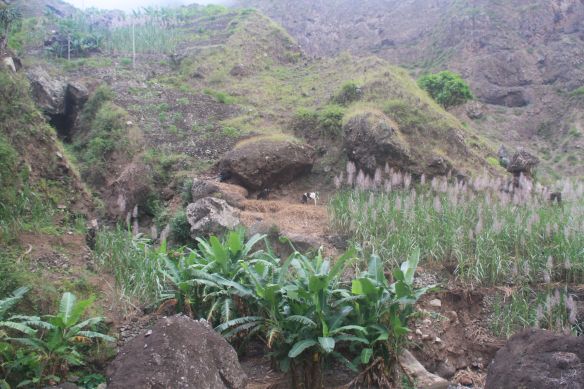
Just before dark the path ended at the road, where we picked up an aluguer (local collective transport) for the steep ride back to Casa Cavaquinho and a wonderful dinner of local produce. Unfortunately, we could only stay one night at Casa Cavaquinho. Following their directions, we walked up the dauntingly steep hills to the volcanic crater of Cova de Paul. This walk was more straight forward – walk through the village, turn hard right at Bob Marley, and keep walking up!

The village is about 500m above sea level and the crater about 1200m. Very quickly we were level with ‘Sandra’s place’ – we couldn’t quite believed where we had climbed the day before.


The path is in great condition, cobbled most of the way. The views……


After about 2 hours, we reached the Cova de Paul.
 The weather has been unusually unsettled, the ‘rainy’ season is usually August, September, but we had some rain most days, luckily not so heavy as to stop us walking. We lunched at Biosfera, the only restaurant at the top, a rather quirky place run by an Italian. Luckily we met up with Amilcar, a very pleasant local driver who helped us out with transport for the rest of our stay. The road between the Crater and Ribeira Grande at the coast is like nothing we had ever seen before. The road, which winds along the top of ridge, affording spectacular views down the valleys on either side.
The weather has been unusually unsettled, the ‘rainy’ season is usually August, September, but we had some rain most days, luckily not so heavy as to stop us walking. We lunched at Biosfera, the only restaurant at the top, a rather quirky place run by an Italian. Luckily we met up with Amilcar, a very pleasant local driver who helped us out with transport for the rest of our stay. The road between the Crater and Ribeira Grande at the coast is like nothing we had ever seen before. The road, which winds along the top of ridge, affording spectacular views down the valleys on either side.
 Our second night was spent in Ponta do Sol, where we a great meal at La Calheta. The hotel was modern and comfortable, but in the weirdest position, a disused airstrip then the coast in front, a big of a garbage dump with chickens, kittens and a very annoying rooster behind!
Our second night was spent in Ponta do Sol, where we a great meal at La Calheta. The hotel was modern and comfortable, but in the weirdest position, a disused airstrip then the coast in front, a big of a garbage dump with chickens, kittens and a very annoying rooster behind!


 Ponto do Sol is a good place to stay before the spectacular walk along the coast to Fontainhaus. Corvo, then Forminghaus. Part of the track had been damaged by recent rain so we didn’t go the whole way.
Ponto do Sol is a good place to stay before the spectacular walk along the coast to Fontainhaus. Corvo, then Forminghaus. Part of the track had been damaged by recent rain so we didn’t go the whole way.
On the outskirts of Ponto do Sol is a pig farm with the best views. In most other places this would be the site of a 5 star hotel.
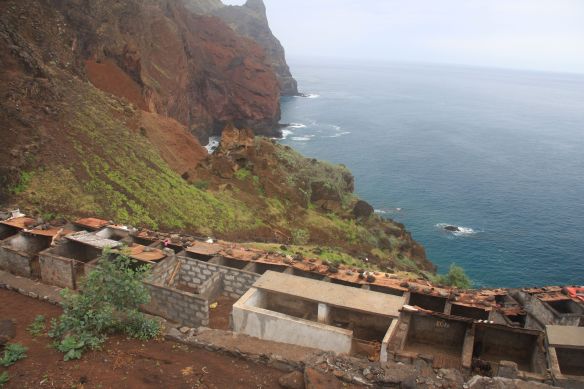


The track was rated as easy, but there sure was a lot of up and down, luckily once again on very well made and maintained cobbled paths.

There are terraces everywhere
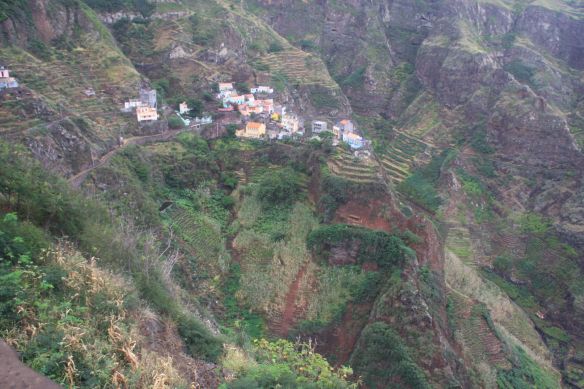
Fontainhaus


Corvo

We were meant to stay in Kasa XoXo the next night, where Tine and Gordon would join us. A bungle in the booking meant we ended up back near the rather colourful Riberia Grande, then made the trek up to Xoxo the next morning.
Being Sunday, some of the locals were in their finery heading to church, while many others worked.


XoXo sits at the head of the Ribeira da Torre, which is narrower and steeper than the Paul valley.


Erosion is a big problem here, the rains must really come down in a torrent given the size of the watercourse.

We walked up to Agua de Rabo Curto, passing through many small villages along the way.









Kasa Xoxo staff
Our last day we drove back over the middle of the island then

walked back down from Cova de Paul into the valley,






 into the valley for a coffee at Pension Chez Sandro.
into the valley for a coffee at Pension Chez Sandro.

then down to Passagem past many locals



before heading back to get the 4pm ferry from Porto Novo to Mindelo.
Our impression of Cape Verde – a place you should not miss! Not only is it the logical stop for sailors en route to the Caribbean, it is a place to wonderful experience. We arrived back in Mindelo to find the marina full of ARC rally boats on the docks and in the bay. After days of no wind and wallowing out in the Atlantic, many have stopped here to wait for the trade winds to kick in. The forecast is looking good for tomorrow – hopefully we will provision and cast lines heading for Barbados (you’ll be pleased to hear that John Reid!).

 It is either a short dinghy ride to one of the many dinghy docks in the town, or a walk along the coastal path, past the picturesque restaurant and shops along the waterfront.
It is either a short dinghy ride to one of the many dinghy docks in the town, or a walk along the coastal path, past the picturesque restaurant and shops along the waterfront.
 The tropical fruit at the Rasta market was delicious, but of course ended up being overpriced as I’m not good at bargaining.
The tropical fruit at the Rasta market was delicious, but of course ended up being overpriced as I’m not good at bargaining.

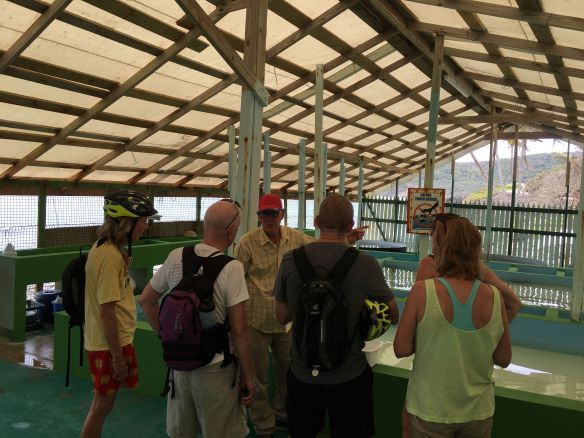 The Sugar Reef resort in the old plantation building was a delightful place for lunch.
The Sugar Reef resort in the old plantation building was a delightful place for lunch.



 Alik, the sail and canvas maker in Bequia had been recommended. His service was fast and very good.
Alik, the sail and canvas maker in Bequia had been recommended. His service was fast and very good.
 The famous Basil’s Bar was being demolished, a disappointment as it was the place to go on Mustique.
The famous Basil’s Bar was being demolished, a disappointment as it was the place to go on Mustique.






 The lunch time view over the bay from Firefly was beautiful, unfortunately the meal very ordinary and overpriced.
The lunch time view over the bay from Firefly was beautiful, unfortunately the meal very ordinary and overpriced.



 Chatham Bay on the lee side of Union Island, was a wonderfully calm anchorage after days of sitting in the wind. Apart from the numerous small establishments offering beach barbeques, there is nothing much here, except, once again, the big Sea Cloud.
Chatham Bay on the lee side of Union Island, was a wonderfully calm anchorage after days of sitting in the wind. Apart from the numerous small establishments offering beach barbeques, there is nothing much here, except, once again, the big Sea Cloud.



 Happy Island, a small island on the reef was built by a local out of conch shells. At sunset the bar was a very lively spot, with very interactive dancing staff and killer rum punches.
Happy Island, a small island on the reef was built by a local out of conch shells. At sunset the bar was a very lively spot, with very interactive dancing staff and killer rum punches.




 The Dockyard has been beautifully restored.
The Dockyard has been beautifully restored.
 Some of the beautiful old yachts are here – Antigua race week is less than a month away.
Some of the beautiful old yachts are here – Antigua race week is less than a month away.

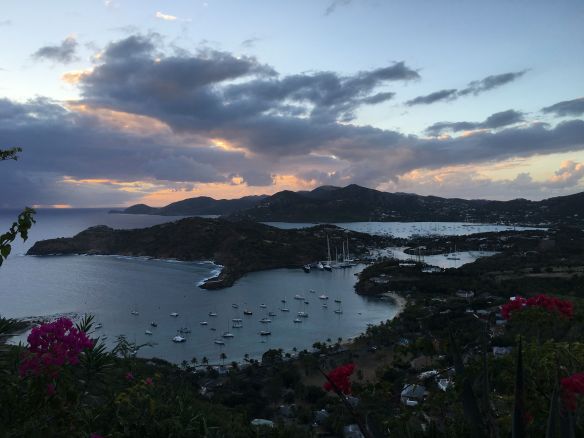




 Antigua was a good place to get jobs done, our hair cut, and enjoy the Dockyard.
Antigua was a good place to get jobs done, our hair cut, and enjoy the Dockyard.
 The wind dropped below 30knots, and the seas below 3m, time for us to leave for Dominica.
The wind dropped below 30knots, and the seas below 3m, time for us to leave for Dominica.
 The local town of Portsmouth is very colourful, the dogs friendly and the beach lovely.
The local town of Portsmouth is very colourful, the dogs friendly and the beach lovely.


 A tour of the north of the island took us through small colourful villages, rainforests and fishing villages.
A tour of the north of the island took us through small colourful villages, rainforests and fishing villages.

 One village boast being the home of the oldest woman in the world.
One village boast being the home of the oldest woman in the world.



 David, one of Cobra’s team was our guide for an early morning tour along the Indian River, spotting many river birds, crabs and iguanas along the way.
David, one of Cobra’s team was our guide for an early morning tour along the Indian River, spotting many river birds, crabs and iguanas along the way.


 Dominica is so green – lots of rainbows, and rain.
Dominica is so green – lots of rainbows, and rain.
 After a few days of sun, the rain had set in. We left Portsmouth for Roseau, the capital of Dominica hoping to do some walks.
After a few days of sun, the rain had set in. We left Portsmouth for Roseau, the capital of Dominica hoping to do some walks.




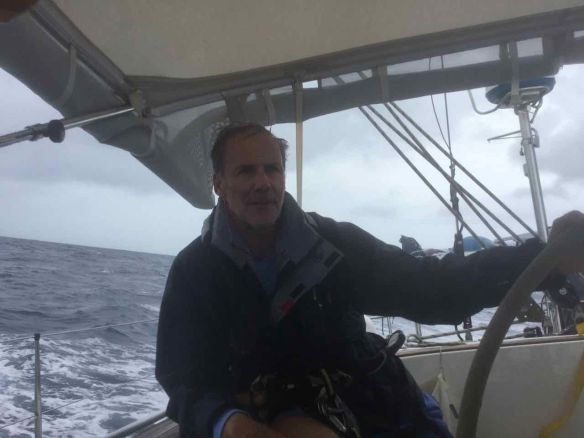 We thought we’d have plenty of time to explore the Caribbean slowly, but here we are with only a month before we need to be in Curacao. The sailing has been great, with Sea Cloud and crew speeding down through the Leeward Islands, with just short overnight stops before moving on to the next island. We’ll spend our last few weeks in the Grenadines and Grenada, hopefully relaxing, before our 4 day passage across to Bonaire in the ABC islands.
We thought we’d have plenty of time to explore the Caribbean slowly, but here we are with only a month before we need to be in Curacao. The sailing has been great, with Sea Cloud and crew speeding down through the Leeward Islands, with just short overnight stops before moving on to the next island. We’ll spend our last few weeks in the Grenadines and Grenada, hopefully relaxing, before our 4 day passage across to Bonaire in the ABC islands.










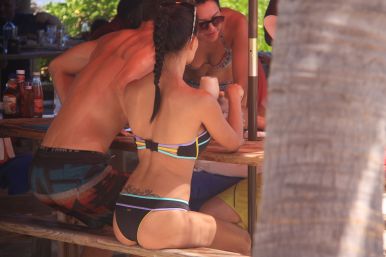




 The daily 7.30am net on Channel 10 was a great source of information. There is a real cruising community here – it seems many cruisers settle in here, stay for weeks and I think some never leave. We settled into a routine of shopping at the great chandleries, the inevitable sitting around waiting for service people to come and meeting other cruisers at the Lagoonies happy hour. It was wonderful to meet up with Karen and Dave Bowes almost a year to the day since they stayed with us in Sydney. We’d last seen them in Gibraltar, so had so much catching up to do. Ian and Dave didn’t stop discussing boats and widgets..
The daily 7.30am net on Channel 10 was a great source of information. There is a real cruising community here – it seems many cruisers settle in here, stay for weeks and I think some never leave. We settled into a routine of shopping at the great chandleries, the inevitable sitting around waiting for service people to come and meeting other cruisers at the Lagoonies happy hour. It was wonderful to meet up with Karen and Dave Bowes almost a year to the day since they stayed with us in Sydney. We’d last seen them in Gibraltar, so had so much catching up to do. Ian and Dave didn’t stop discussing boats and widgets..


 Saba can be a tricky place for yachts, as it has limited shelter in a number of winds and can be affected by swell. What it does have is good, secure mooring buoys on the west and south coasts and a safe dinghy dock in the harbour at Fort Bay. With relatively calm conditions and Sea Cloud secured to a mooring buoy off Fort Bay we had the opportunity to explore this gem of an island.
Saba can be a tricky place for yachts, as it has limited shelter in a number of winds and can be affected by swell. What it does have is good, secure mooring buoys on the west and south coasts and a safe dinghy dock in the harbour at Fort Bay. With relatively calm conditions and Sea Cloud secured to a mooring buoy off Fort Bay we had the opportunity to explore this gem of an island.








 Unfortunately we only had time for one of the many walks on the island.
Unfortunately we only had time for one of the many walks on the island.














 Our timing was impeccable, we arrived the day before Carnivale. Gustavia town closes completely and everyone dresses up whether or not they are part of the main parade. Lots of fun, colour and movement and music.
Our timing was impeccable, we arrived the day before Carnivale. Gustavia town closes completely and everyone dresses up whether or not they are part of the main parade. Lots of fun, colour and movement and music.












 Driving the winding roads is the only way to explore the island which has no public transport. The views are spectacular and the island and beaches very beautiful.
Driving the winding roads is the only way to explore the island which has no public transport. The views are spectacular and the island and beaches very beautiful.




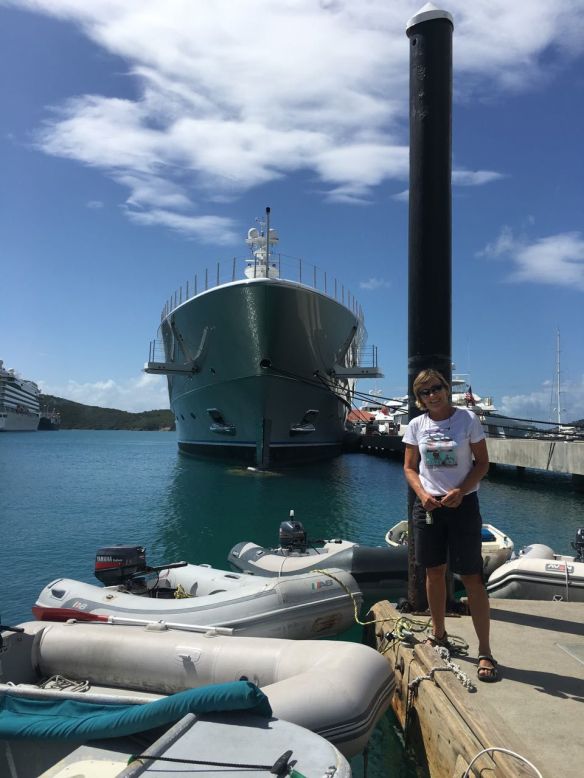

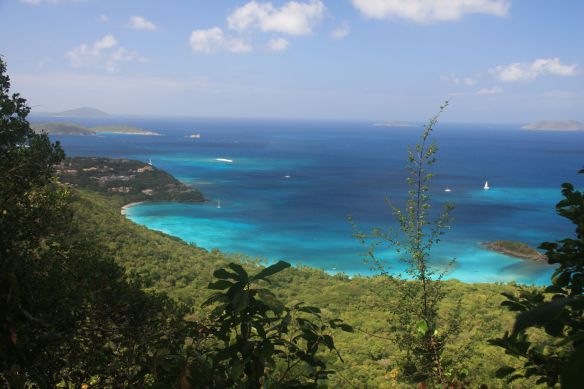



 and walked around to the beautiful White Beach,
and walked around to the beautiful White Beach,
 where we (as one does) drank our painkillers in the water.
where we (as one does) drank our painkillers in the water. then relaxed on the beach – something we never do
then relaxed on the beach – something we never do
 Benures Bay on Norman Island was beautiful, close to ‘the Indians’ for a morning snorkel.
Benures Bay on Norman Island was beautiful, close to ‘the Indians’ for a morning snorkel. After an anniversary dinner on Cooper Island (where it all began), we sailed to Anegada, the northernmost island in the BVI. We had hesitated about coming here as it is shallow! As the conditions were so calm we decided to try as it made a logical spot from which to sail to St Maarten. With a maximum height of only about 6metres, from a distance all you can see is a long spit of sand, beautiful blue water and a few trees.
After an anniversary dinner on Cooper Island (where it all began), we sailed to Anegada, the northernmost island in the BVI. We had hesitated about coming here as it is shallow! As the conditions were so calm we decided to try as it made a logical spot from which to sail to St Maarten. With a maximum height of only about 6metres, from a distance all you can see is a long spit of sand, beautiful blue water and a few trees. By the look of the charts, with Sea Cloud’s draft of 2.35m, we should have been able to get into the anchorage (just). But as the depth gauge read 2.1m, we made a hasty retreat, fortunately without touching bottom.
By the look of the charts, with Sea Cloud’s draft of 2.35m, we should have been able to get into the anchorage (just). But as the depth gauge read 2.1m, we made a hasty retreat, fortunately without touching bottom. 






 As we’d had gusts of 30knots just outside, anchoring further into the bay was a better option for us.
As we’d had gusts of 30knots just outside, anchoring further into the bay was a better option for us.


 and a good sense of humour.
and a good sense of humour.

 Bahia de Tortuga on Culebrita island was a picture perfect Caribbean anchorage. You would not want to be here in northerly swells. Although the bay was calm overnight the relatively small breaking swell on the way out through the gap in the reef was nasty. It would be treacherous in big seas.
Bahia de Tortuga on Culebrita island was a picture perfect Caribbean anchorage. You would not want to be here in northerly swells. Although the bay was calm overnight the relatively small breaking swell on the way out through the gap in the reef was nasty. It would be treacherous in big seas.

 and Lindsay left freezing Ottawa to join us for a week of sun and sailing on Sea Cloud. As a big northerly swell was running, we spent most of the week in the beautiful bays on the south coast of St John.
and Lindsay left freezing Ottawa to join us for a week of sun and sailing on Sea Cloud. As a big northerly swell was running, we spent most of the week in the beautiful bays on the south coast of St John.



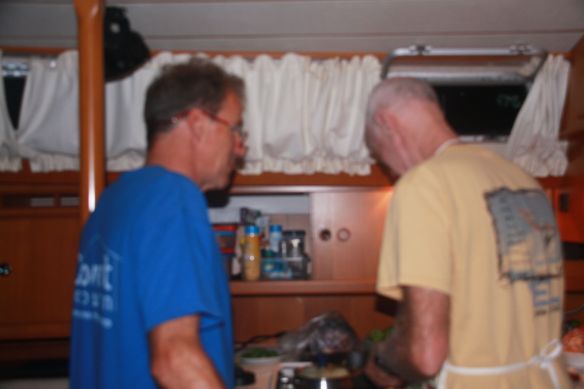


 Swimming with the turtles and snorkelling over the reef behind the boat were daily treats.
Swimming with the turtles and snorkelling over the reef behind the boat were daily treats.

 We had planned for a big dinner at Caneel Bay where John had helped us celebrate our engagement in 1986. Unfortunately it was too rough to take Sea Cloud there, so we visited the lovely resort by taxi instead.
We had planned for a big dinner at Caneel Bay where John had helped us celebrate our engagement in 1986. Unfortunately it was too rough to take Sea Cloud there, so we visited the lovely resort by taxi instead.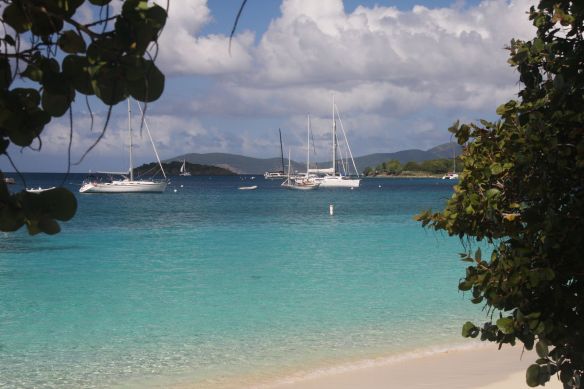








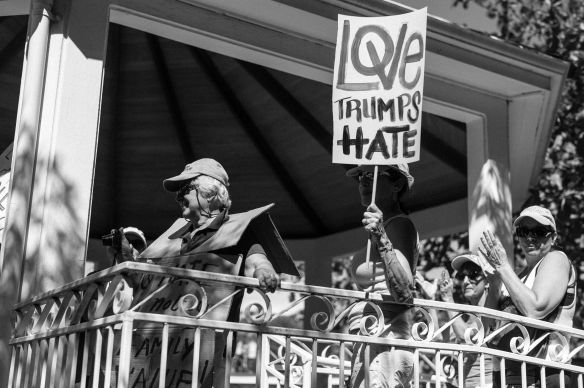



 After dinner at Foxy’s and a big night with the locals for Andrew and Sam, we sailed to North Sound at Virgin Gorda, catching a few more fish on the way. We anchored off Saba Rock close to the Bitter End Yacht Club.
After dinner at Foxy’s and a big night with the locals for Andrew and Sam, we sailed to North Sound at Virgin Gorda, catching a few more fish on the way. We anchored off Saba Rock close to the Bitter End Yacht Club.






 Andrew Emily and Sam prepared a lunch BBQ’d fresh fish.
Andrew Emily and Sam prepared a lunch BBQ’d fresh fish.



 We hadn’t realised that there was good snorkelling on the reef off Cooper Island.
We hadn’t realised that there was good snorkelling on the reef off Cooper Island.










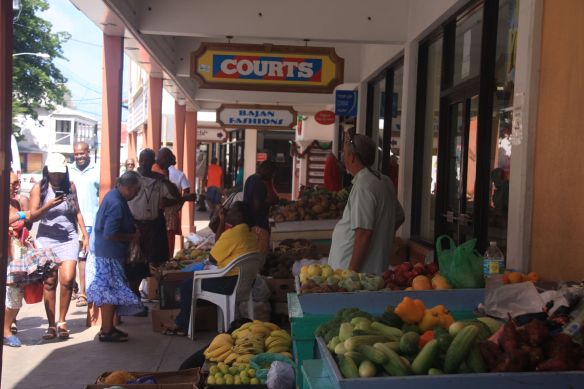

 The anchorage of Carlisle bay off Bridgetown was pleasant enough, if you didn’t mind a bit of loud music at night.
The anchorage of Carlisle bay off Bridgetown was pleasant enough, if you didn’t mind a bit of loud music at night.








 Since arriving here, we’ve had heavy rain most days with beautiful rainbows.
Since arriving here, we’ve had heavy rain most days with beautiful rainbows.

 We only had one night in Dominica (more to come, we hope).
We only had one night in Dominica (more to come, we hope).







 Our last few days with Tine and Gordon were spent at Pigeon Island, a beautiful anchorage with fabulous snorkelling with the turtles right off the boat. We also had our first scuba dive in the Caribbean.
Our last few days with Tine and Gordon were spent at Pigeon Island, a beautiful anchorage with fabulous snorkelling with the turtles right off the boat. We also had our first scuba dive in the Caribbean.
 La Touna near the anchorage was a fitting farewell meal for Gordon and Tine – great food in a wonderful setting.
La Touna near the anchorage was a fitting farewell meal for Gordon and Tine – great food in a wonderful setting. Tine and Gordon were great crew for our Atlantic crossing. They headed back to cold, dark Copenhagen while we sail north towards Montserrat for New Year.
Tine and Gordon were great crew for our Atlantic crossing. They headed back to cold, dark Copenhagen while we sail north towards Montserrat for New Year. We have about a week island hopping our way north to the Virgin Islands where we meet friends and family in mid January.
We have about a week island hopping our way north to the Virgin Islands where we meet friends and family in mid January. We ate well – we rotated responsibility for meals
We ate well – we rotated responsibility for meals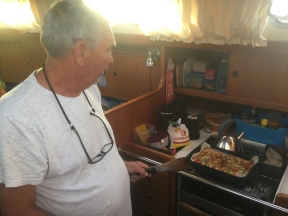







 The fishing was so good, we had to limit Ian from putting out the line. No one wanted fish EVERY night.
The fishing was so good, we had to limit Ian from putting out the line. No one wanted fish EVERY night.







 While on watch we tweaked Ted, (the Hydrovane) who steered us across the ocean.
While on watch we tweaked Ted, (the Hydrovane) who steered us across the ocean. We enjoyed some wonderful sunrises and Atlantic clouds
We enjoyed some wonderful sunrises and Atlantic clouds




 Our last night was the worst of the passage. We had 12 hours of constant squalls, wind shifts and strong gusts with very confused high seas. No one slept. We were pleased to have experienced this short taste of not so pleasant Atlantic weather. It reinforced just how lucky we had really been.
Our last night was the worst of the passage. We had 12 hours of constant squalls, wind shifts and strong gusts with very confused high seas. No one slept. We were pleased to have experienced this short taste of not so pleasant Atlantic weather. It reinforced just how lucky we had really been.


 Having delivered Sea Cloud and crew safely to the other side, the skipper could finally relax!
Having delivered Sea Cloud and crew safely to the other side, the skipper could finally relax! 



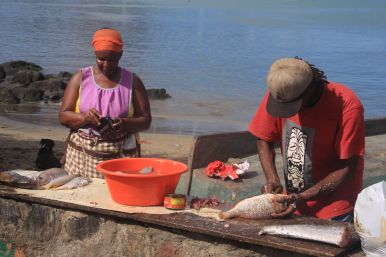















 As we cautiously trekked down the cobbled paths we pass the locals carrying their produce or building products.
As we cautiously trekked down the cobbled paths we pass the locals carrying their produce or building products.




 Five families (and a few pigs) live on the ridge. The children have an hour’s walk (took us 2) down a steep path to nearest school.
Five families (and a few pigs) live on the ridge. The children have an hour’s walk (took us 2) down a steep path to nearest school.











 The weather has been unusually unsettled, the ‘rainy’ season is usually August, September, but we had some rain most days, luckily not so heavy as to stop us walking. We lunched at Biosfera, the only restaurant at the top, a rather quirky place run by an Italian. Luckily we met up with Amilcar, a very pleasant local driver who helped us out with transport for the rest of our stay. The road between the Crater and Ribeira Grande at the coast is like nothing we had ever seen before. The road, which winds along the top of ridge, affording spectacular views down the valleys on either side.
The weather has been unusually unsettled, the ‘rainy’ season is usually August, September, but we had some rain most days, luckily not so heavy as to stop us walking. We lunched at Biosfera, the only restaurant at the top, a rather quirky place run by an Italian. Luckily we met up with Amilcar, a very pleasant local driver who helped us out with transport for the rest of our stay. The road between the Crater and Ribeira Grande at the coast is like nothing we had ever seen before. The road, which winds along the top of ridge, affording spectacular views down the valleys on either side. Our second night was spent in Ponta do Sol, where we a great meal at La Calheta. The hotel was modern and comfortable, but in the weirdest position, a disused airstrip then the coast in front, a big of a garbage dump with chickens, kittens and a very annoying rooster behind!
Our second night was spent in Ponta do Sol, where we a great meal at La Calheta. The hotel was modern and comfortable, but in the weirdest position, a disused airstrip then the coast in front, a big of a garbage dump with chickens, kittens and a very annoying rooster behind!

 Ponto do Sol is a good place to stay before the spectacular walk along the coast to Fontainhaus. Corvo, then Forminghaus. Part of the track had been damaged by recent rain so we didn’t go the whole way.
Ponto do Sol is a good place to stay before the spectacular walk along the coast to Fontainhaus. Corvo, then Forminghaus. Part of the track had been damaged by recent rain so we didn’t go the whole way.
































 into the valley for a coffee at Pension Chez Sandro.
into the valley for a coffee at Pension Chez Sandro.


